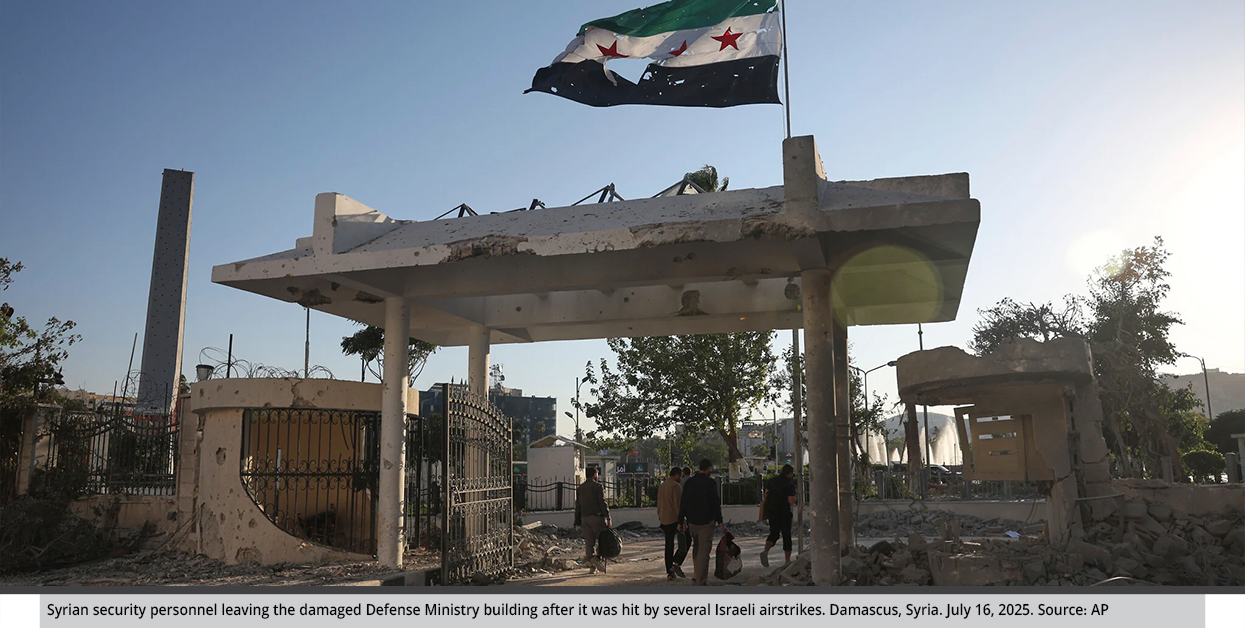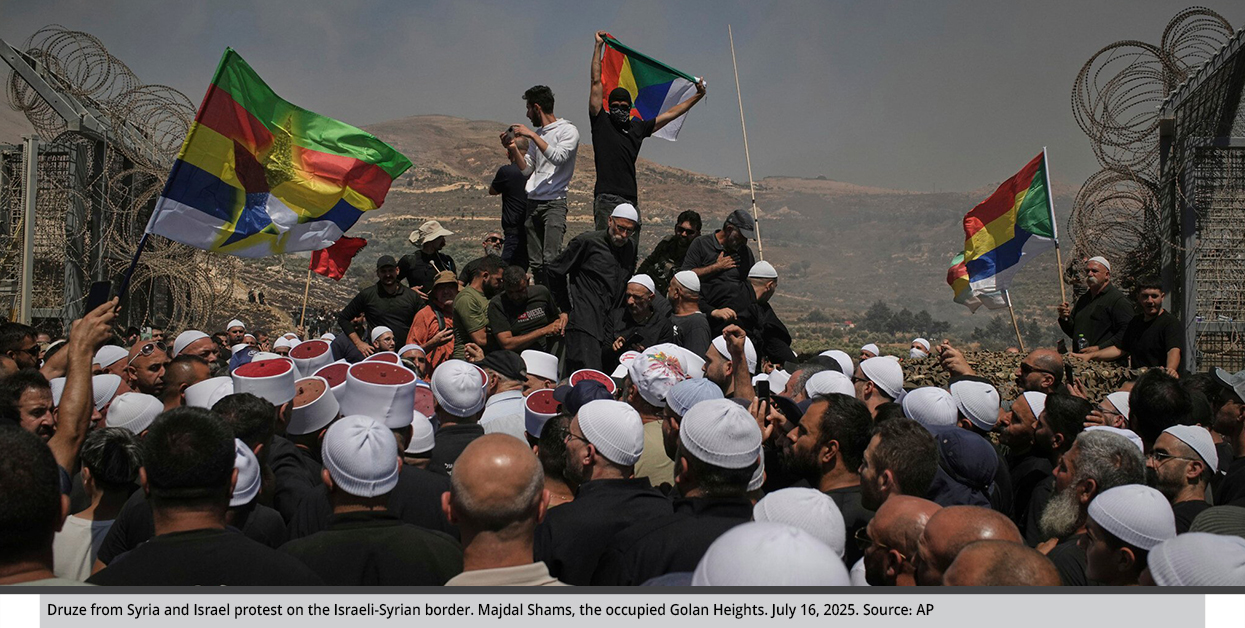Israel and Southern Syria: Limits of Power and Parameters of Settlement in Suwayda
The Suwayda Governorate in southern Syria witnessed a significant security escalation following clashes between Druze factions and Bedouin tribes, which was followed by a military intervention by the Syrian transitional government. This prompted Israel to carry out airstrikes, which it considered a response to the violation of the “demilitarized zone” principle and its commitments toward the Druze community. As a result, Syrian forces withdrew and a ceasefire agreement was signed with the religious authority in Suwayda that also included local security and administrative arrangements. These developments revealed a gap in the transitional government’s understanding of the Israeli position, placing its presence in the south—and its relations with the Druze and Kurds—under challenges that may reshape the balance of power.
by STRATEGIECS Team
- Release Date – Jul 17, 2025

This opinion article is part of the series: Syria.. Transformations, Variables, and the Future of the State of Uncertainty
The Syrian landscape has witnessed complex security developments in the south, particularly in the Suwayda Governorate, against the backdrop of overlapping dynamics between the Syrian transitional government, Israel, and the Druze community in both countries. These developments escalated from limited clashes between local armed groups into a broad Israeli military escalation against the army and security forces affiliated with the transitional government.
This conflict revealed a clear gap in the transitional government’s understanding of Israel’s position and its level of commitment to preventing transitional authority forces from entering southern Syria. Israel seeks to maintain the area as a “demilitarized zone,” thereby reestablishing the rules of engagement and recalibrating the balance of power in the border region between the two countries.
Tensions in Suwayda and their developments
Tensions in Suwayda began with reciprocal kidnappings between Druze armed factions and Bedouin tribes, escalating significantly into continuous clashes on July 13 and 14 that, according to the Syrian Ministry of Interior, left more than 30 people dead and around 100 injured. In response, the Syrian transitional government deployed military forces—including tanks and armored vehicles—to the area between Daraa and Suwayda.
On July 14, these forces succeeded in seizing control of the Druze village of Al-Mazraa on the outskirts of Suwayda, enabling them to push further into the city’s neighborhoods and come into direct confrontation with armed factions loyal to Hikmat al-Hijri, one of three spiritual leaders of the Druze community in Suwayda. Al-Hijri, who has close ties with Israel and wants the Druze to establish autonomy in Syria, rejected the entry of transitional authority forces and called for international intervention to protect the governorate.
However, the turning point came on July 15, when the mission of the Syrian forces shifted from enforcing calm to establishing full control over Suwayda, launching sweeping operations in its neighborhoods to hunt down opposing armed elements. This move prompted Israel to view the developments as a breach of the demilitarized zone principle in southern Syria and a violation of Israel’s commitments to Syrian Druze. Consequently, Israel launched strikes on July 14 and 15 targeting tanks and military vehicles headed toward Suwayda, and, on July 16, it expanded its operations to strike multiple military sites in Damascus, Daraa, and Latakia.
Accordingly, the Israeli intervention prompted the withdrawal of the Syrian army and security forces from the areas they had taken over in Suwayda and its surroundings. A ceasefire agreement was reached with the Druze religious leadership, including spiritual leader Sheikh Youssef Jarbou, and other local dignitaries. To eliminate any armed presence outside the framework of the state while also respecting the governorate’s unique social and historical character, the agreement stipulated a cessation of hostilities among all parties and the regulation of heavy weapons in coordination with the ministries of Interior and Defense.
The agreement also included Suwayda’s commitment to full integration into state institutions and the reactivation of all official governmental bodies. Furthermore, it mandated the formation of a committee to investigate crimes and violations, the release of detainees, and the establishment of a joint committee to oversee implementation.

Notably, these developments mark the most wide-ranging and escalatory Israeli intervention in the arrangements of southern Syria to date, particularly when compared to previous incidents such as those in the Sahnaya and Jaramana areas south of Damascus on April 30. At that time, Israel intervened in the ongoing tensions by carrying out a warning strike against armed groups aligned with the transitional government, followed by a more explicit warning strike near the Presidential Palace in Damascus on May 2.
Nonetheless, the recent developments reveal a broader aspect of Israel’s approach toward southern Syria and the transitional government—especially given that they occurred just two days after direct talks were held between the two sides in Azerbaijan on July 12.
A Reading of the Israeli Move
Israel’s actions following the security developments in the city of Suwayda reflect a high degree of precision and phased discipline, characterized by an escalation shaped by a set of conflicting variables and pressures.
First, the response was based on a delicate balance between U.S. pressure and demands to avoid direct involvement inside Syria, and Israel’s perceived necessity to intervene in order to uphold its commitments to the Druze community—both within Israel and in Syria—especially as dozens of Druze individuals crossed into Syrian territory.
Second, the intervention was gradual and calculated to preserve the framework of Israel’s security approach in southern Syria and to prevent any attempts by Syrian forces to breach it, without triggering a broader destabilization of the country’s already fragile stability.
In this context, the Israeli military action carried clear and multi-layered political and military messages directed at the Syrian transitional government. This was evident in strikes launched beyond southern Syria, including direct targeting the Ministry of Defense building. These attacks caused significant damage and signaled a serious expansion of Israel’s deterrence strategy.
Notably, Israel refrained from striking the Presidential Palace directly, opting instead to shell its surroundings, marking the second such instance following an Israeli strike in May. In both cases, the strikes were responses to events tied to the south, serving as a clear indication that the scope and objectives of Israeli intervention could extend toward applying pressure for regime change.
At the same time, Israel’s strikes demonstrated its ability to complicate the transitional government’s efforts to establish control by targeting the headquarters of the 107th and 132nd Brigades in the Latakia countryside, an area known for its delicate balance and highly sensitive political relationships.
Nonetheless, the Israeli strikes remained limited in both scope and objectives, as Israel is keen to avoid turning its precautionary measures into a strategic miscalculation that could backfire. For instance, an expansion of sustained strikes across Syria could undermine the country’s fragile stability and risk dragging it back into a state of chaos that would ultimately benefit Iranian-backed militias and terrorist organizations, which Israel seeks to avoid.
Moreover, providing decisive support to the Druze against the New Syrian Army could jeopardize their future standing within Syria’s social fabric, especially since Druze independence or integration into Israel are not viable options. This reality is well understood by a broad segment of the Druze community, including figures like Laith al-Balaous and Walid Jumblatt in Lebanon, who both openly support the Syrian government and have positioned themselves in opposition to the alliance of al-Hijri and Mowafaq Tarif, the spiritual leader of the Druze community in Israel, who both reject the legitimacy of the transitional government.
On the other hand, Israel wants the Syrian army to remain strong along the western border with Lebanon—but not the southern border with Israel. This position is rooted in the fact that both sides share a common hostility toward Iran and a mutual interest in weakening Hezbollah. These shared priorities are likely to be reinforced amid growing signs that Israel may carry out a military operation against Hezbollah, particularly in light of the group’s refusal to surrender its remaining weapons north of the Litani River in Lebanon.
In this context, the New Syrian Army could become increasingly important as a tool to pressure Hezbollah from the Syrian side of the border. The two sides—Israel and the Syrian army—have precedent for such coordination. In mid-March, for example, the Syrian army conducted a military operation in the village of Hawsh al-Sayyid Ali, located on the Syrian-Lebanese border, to expel Hezbollah fighters who had been using the area for smuggling drugs and goods. Then, in mid-May, the Syrian army shelled Lebanese villages under Hezbollah’s control after the group kidnapped Syrian soldiers and took them to Lebanon for execution.
Points of “Misunderstanding” Between Syria and Israel
The recent developments reveal a misreading and miscalculation on the part of the Syrian transitional government regarding Israel’s broader approach to the Syrian landscape—particularly in its failure to distinguish between the diplomatic and operational-military levels. The transitional government appeared to interpret the negotiation rounds, which began indirectly in May and later evolved into direct meetings in Azerbaijan in July, as signaling a fundamental shift in Israel’s stance: diplomacy instead of military action.
However, this assessment overlooked Israel’s core security considerations and its consistent approach toward southern Syria. Despite the softer tone in Israeli rhetoric regarding the transitional government, its actions and strategic discourse have remained firmly rooted in military escalation regarding any attempt to alter the balance of power in southern Syria.
In reality, Israel has adopted a dual-track approach in its handling of the Syrian file, clearly distinguishing between two main levels: a willingness to engage with the Syrian transitional government while simultaneously maintaining deep concerns about the Syrian army and security forces formed from former opposition factions, both of which include hardline anti-Israel members in their ranks.
Accordingly, Israel views the movement of these forces toward Suwayda and the broader southern region as crossing a “red line” that guards against the possibility of undisciplined, individual actions along the border with Israel—actions that, from the Israeli perspective, would sustain or even heighten security risks. This concern was reinforced by the undisciplined combat record of these forces during military operations along the Syrian coast between March 6 and 10 and the subsequent events in Suwayda, which exposed weaknesses in field discipline and operational coordination.

On the other hand, the red lines drawn by Israel regarding the advance of Syrian forces into the south are closely linked to its strategic vision for any potential formal negotiations with Syria. Israel considers full recognition of its sovereignty over the occupied Golan Heights as a non-negotiable condition for any future agreement. This, in effect, implies the abandonment of the Israeli-Syrian 1974 Disengagement Agreement and the transitional government’s acceptance of ceding Syrian territory to Israel.
Until such a final understanding is reached, Israel insists on keeping the occupied Golan Heights fortified by establishing a buffer zone stretching from the Israeli border to the Damascus countryside, encompassing the entire southern region of Syria. This buffer zone serves as a permanent security barrier and is also leveraged by Israel as a bargaining chip in any negotiations—whether related to limited security agreements or broader normalization tracks.
In this framework, the transitional government’s restoration of sovereignty over the south becomes a more urgent and realistic objective than reclaiming areas under Israeli occupation in the Golan following the regime change. Practically speaking, the Syrian government could present any breakthrough in this regard as a tangible achievement of the negotiation process.
In conclusion, the recent outcomes of these developments have, in effect, constituted a compromise between both parties. The Syrian army and security forces withdrew following the Israeli military operations in exchange for an agreement to assign leadership and operational roles in managing the security file to Druze officers and police personnel from Suwayda itself.
However, despite the agreement, clashes that had first erupted July 14 between armed groups loyal to al-Hijri and Bedouin tribes resumed July 17. This recurrence places the transitional government in a difficult position. If it intervenes again, it risks facing further Israeli strikes. But if it remains neutral, it risks being criticized for weakness and failure to protect Syrians.
More broadly, the transitional government’s faltering in Suwayda and its acceptance of solutions that fall short of its ambitions for full sovereignty cast a shadow over its future negotiations with the Syrian Democratic Forces. This may even pave the way for the emergence of a potential Druze–Kurdish alliance in opposition to the transitional government.

STRATEGIECS Team
Policy Analysis Team
 العربية
العربية